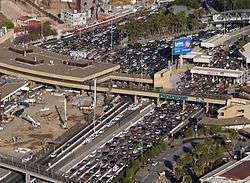Friendship Park (San Diego–Tijuana)
Friendship Park is a half-acre binational park located along the United States-Mexico border in the San Diego–Tijuana region.[1][2] Located within the larger Border Field State Park in California's San Diego county, the park includes the border fence dividing the two countries where residents of both countries can meet in person.[3] On the U.S. side, the park used to be part of the Monument Mesa picnic area but is now wholly located on federal property under the Department of Homeland Security[4] and is heavily monitored by U.S. Border Patrols 24 hours a day.[5]
History
In 1848, the U.S. built a pyramidal statue on the San Diego beach to mark the end of the Mexican-American War and the initial boundary point between Mexico and U.S. On August 18, 1971, Friendship Park was inaugurated by then-First Lady Pat Nixon as a symbol of binational friendship, when it was declared a national monument.[6][7] Until 1994, there was no border fence, and anyone can meet on the border under the supervision of the U.S. Border Patrol. Various social events have taken place in this park, including yoga classes, religious services, weddings, dancing, and baptisms.[2][8] In 1994 amidst widespread hysteria about unauthorized immigration between San Diego and Tijuana, a 14-mile long fence was constructed on the border between San Diego and Tijuana as part of Operation Gatekeeper, including one in Friendship Park.[7][2] Border security was tightened in the 1990s and again after the September 11 terrorism attacks in 2001. During that time, people on opposite sides of the border were still able to touch and pass objects through the barrier.[9] In 2009, the U.S. Department of Homeland Security closed down Friendship Park and a second parallel fence was created which stretches into the Pacific Ocean that includes barbed wires, sensors, and surveillance cameras. A 20-foot wide border patrol access road was also created, along with a third 20-foot wall of steel bars.[7]
In late 2011 and early 2012, the “Surf Fence” Project replaced the old bars that form a barrier on the beach and extended it 300 feet into the ocean.
In 2012, under pressure from the public and activist groups, the federal government agreed to reopen the park with an outer perimeter fence blocking access to the public except when permitted by the U.S. Border Patrol, which controls access to the park.[10] The fence dividing the two countries is now a thick, dense steel mesh that is difficult to see through and only allows the touching of fingertips.[10]
Children's Day
Due to the work of the humanitarian organization Border Angels and its founder Enrique Morones, the U.S. government now allows a door in the fence at Friendship Park to be opened briefly on Children's Day, a holiday celebrated in April in Mexico. The first such event took place in 2013, and it was repeated in 2015 and 2016. When it is opened, Border Patrol officers lift a steel girder that locks a solitary gate in the fence from the U.S. side. Children and adults from pre-selected families divided by the border are allowed to meet and embrace briefly.[11]
Visiting Friendship Park
U.S. side
The U.S. Border Patrol allows public access to the park on Saturdays and Sundays between 10:00 a.m. and 2:00 p.m.[12] Visitors to the park must first enter Border Field State Park on Monument Road either by vehicle or, if vehicle access is closed, by foot for 1.8 miles to reach the park at Monument Mesa. Border Patrol may limit access to the number of visitors allowed in the park and may check IDs. No item can be passed through the fence; this includes food, money, gifts, and notes, and doing so is a customs violation.[13]
Mexico side
There is no access limitation to the park from the Mexico side.[14]
Friends of Friendship Park
Friends of Friendship Park is an organization of community members working for unrestricted access to this historic border site. The organization works on behalf of many families who depend on the park to see their families and friends.[15]
See also
References
- ↑ "friendshippark". friendshippark. Retrieved 2017-12-22.
- 1 2 3 "Friendship Park". At the edges. 2011-12-01. Retrieved 2017-12-23.
- ↑ Elliot Spagat (9 January 2009). "Border Patrol shutting down Friendship Park". SFGate. Associated Press. Retrieved 10 December 2011.
- ↑ "Tijuana Estuary Place Names" (PDF).
- ↑ "friendshippark". friendshippark. Retrieved 2017-12-23.
- ↑ Debbi Baker (20 August 2011). "Friendship Park marks 40th anniversary". The San Diego Union-Tribune. Retrieved 10 December 2011.
- 1 2 3 "There's a bi-national beach on the US-Mexico border where separated families meet — here's what it looks like". Business Insider. Retrieved 2017-12-23.
- ↑ Jason Beaubien (9 February 2009). "Fence Supplants 'Friendship' At U.S.-Mexico Border". NPR. Retrieved 10 December 2011.
- ↑ Randal C. Archibold (22 October 2008). "U.S.-Mexico border fence will split friendship park". The New York Times. Retrieved 10 August 2011.
- 1 2 "Friendship Park -- A Link Between Two Countries -- Opens Again". KPBS Public Media. Retrieved 2016-05-27.
- ↑ Lewis, Paul (2016-03-29). "A wall apart: divided families meet at a single, tiny spot on the US-Mexico border". the Guardian. Retrieved 2016-05-27.
- ↑ "Friendship Park binational meeting place US-Mexico border". Friendship Park binational meeting place US-Mexico border. Retrieved 2016-05-27.
- ↑ "friendshippark". friendshippark. Retrieved 2017-12-22.
- ↑ "friendshippark". friendshippark. Retrieved 2017-12-22.
- ↑ "Friendship Park binational meeting place US-Mexico border". Friendship Park binational meeting place US-Mexico border. Retrieved 2016-05-27.
External links
Coordinates: 32°32′04″N 117°07′20″W / 32.534576°N 117.122353°W
